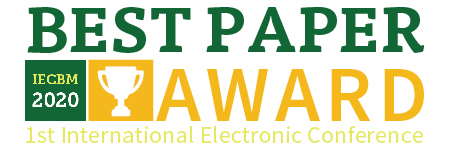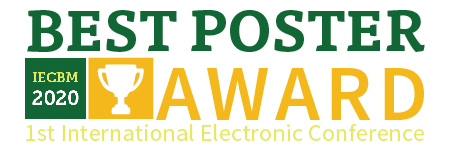
The 1st International Electronic Conference on Biomolecules
Natural and Bio-Inspired Therapeutics for Human Diseases
Part of the International Electronic Conference on Biomolecules series
1–13 December 2020
Drug Discovery, Bio-inspired Therapeutics, Natural Drug Leads
- Go to the Sessions
-
- S1. The natural and bio-inspired drug universe
- S2. Derivatives of natural drugs: when chemistry allows optimization of what was created by nature
- S3. Pathways for the discovery of new bio-inspired and natural drugs and their derivatives
- S4. Repurposing of previously approved natural and bio-inspired drugs
- PS. Poster Session
- Event Details
-
- Welcome from the Chairs
- Conference Chairs
- Conference Speakers
- Sessions
- List of Accepted Submissions
- Live Online Sessions
- Program Live Online Sessions
- Live Online Sessions Content
- Instructions for Authors
- Event Awards
- Awards Winners Announcement
- Special Issue
- Sponsors and Partners
- Events in series IECBM
The Best Paper and Best Poster Award Winners have been announced.
Please see the 'Awards Winner Announcement' section for more details.
Welcome from the Chairs
Dear Colleagues,
It is with great enthusiam that we announce the 1st International Electronic Conference on Biomolecules: Natural and Bio-Inspired Therapeutics for Human Diseases (IECBM2020). The conference is organized by the MDPI open-access journal Biomolecules (Impact Factor 4.082), and will be held online from 1 to 13 December 2020.
Nature has long inspired drug discovery. While synthetic products often fail to meet clinical expectacions, natural products are highly optimized for their in vivo specific functions. The field of natural and bio-inspired therapeutics grows with every new attempt to mimic nature to produce new and succesful drugs targeting a wide variety of human diseases. This conference will provide leading scientists working in the field with an online platform on which to share their latest research and engage in exciting discussions. The main topics and sessions of the conference are:
- The natural and bio-inspired drug universe (Session 1);
- Derivatives of natural drugs: when chemistry allows optimization of what was created by nature (Session 2);
- Pathways for the discovery of new bio-inspired and natural drugs and their derivatives (Session 3);
- Repurposing of previously approved natural and bio-inspired drugs (Session 4).
This online event will bring together researchers from all over the world with no concerns of travel or other related expenditures. Participation and “attendance” to the IECBM2020 are FREE of charge.
The conference invites submissions for abstracts that will be reviewed by the conference committee. The authors of accepted contributions will be invited to submit a conference paper along with a slide or poster presentation of their work. All participants will have the opportunity to examine, explore, and critically engage with research findings published in Sciforum during the conference.
After the conference, all accepted papers will be published in the proceedings of this e-conference within a dedicated issue of the MDPI journal Proceedings. In addition, all participants will be encouraged to submit a full paper to one dedicated Special Issue in Biomolecules with a 20% discount on the Article Processing Charges (APC).
We hope that you will join this e-conference to exchange ideas, start fruitful collaborations, and make this first edition a success—the first of many.
Kind regards,
Prof. Dr. Vladimir Uversky
Prof. Dr. Prakash Kulkarni
Dr. Marc Maresca
The Chairs of the 1st International Electronic Conference on Biomolecules.
Conference Secretariat
M.Sc. Fancy Zhai
Ms. Kayla Wang
Dr. Elena Gonzalez
Email: iecbm2020@mdpi.com
 Follow the conversation on Twitter with #IECBM2020
Follow the conversation on Twitter with #IECBM2020
Conference Chairs

Aix-Marseille University, CNRS, Centrale Marseille, iSm2, F-13013 Marseille, France
Marc Maresca is currently Researcher at the Aix-Marseille Université. He was awarded his PhD in Biochemistry from the Université Paul Cézanne (France, 2003), where he worked on food contaminants termed mycotoxins. In 2003, he moved to England to work on enteropathogenic E. coli in the laboratory of Brendan Keny. He then moved back to France to continue his work on mycotoxins, studying their effects on human health. He is currently working at the Aix-Marseille Université, and his research aims to identify and develop new molecules with antimicrobial properties—natural, synthetic, and bio-inspired. He focuses on antimicrobial peptides and their mimics, as in addition to their antimicrobial effects, they can also be anti-inflammatory and anti-tumorigenic. He has published 52 papers in Q1 journals and 3 patents related to antimicrobial molecules. He also collaborates with food and pharmaceutical industries as a scientific expert and consultant.

Department of Molecular Medicine, Morsani College of Medicine, University of South Florida, Tampa, FL 33612, USA,
Laboratory of New Methods in Biology, Institute for Biological Instrumentation, Russian Academy of Sciences, 142290 Pushchino, Moscow Region, Russia
Vladimir Uversky is Professor at the College of Molecular Medicine, University of South Florida. He is a biophysicist and obtained his PhD and Doctor of Science (DSc) in Physics and Mathematics at the Moscow Institute of Physics and Technology (1991) and at the Institute Experimental and Theoretical Biophysics, Russian Academy of Sciences (1998), respectively. He spent his early career investigating protein folding at the Institute of Protein Research and the Institute for Biological Instrumentation (Russia). In 1998, he moved to the University of California Santa Cruz to work on protein folding, misfolding, and protein intrinsic disorder. In 2004, he joined the Indiana School of Medicine and, in 2010, the University of South Florida, where he has since been continuing his studies on protein folding, misfolding, and intrinsically disordered proteins. Prof. Vladimir Uversky has authored over 850 scientific publications, edited numerous books, and is also serves as the editor of several scientific journals. He was included in Thomson Reuters’ list of Highly Cited Researchers in 2014–2019.

Department of Medical Oncology and Therapeutics Research, City of Hope National Medical Center, Duarte, CA 91010, USA
Prakash Kulkarni, PhD, is currently Research Professor at the Department of Medical Oncology & Therapeutics Research at the City of Hope National Medical Center, Duarte, California. Dr Kulkarni obtained his PhD in Biochemistry from Mangalore University, India, and conducted his postdoctoral training in cell biology at New York University. Subsequently, he has held Staff Scientist positions in the Division of Chemistry and Chemical Engineering as well as in the Division of Biology at the California Institute of Technology, and later, in the Department of Genetics at Yale University. Dr Kulkarni began his independent academic career as Assistant Professor of Urology and Oncology in the Brady Urological Institute at Johns Hopkins University, where he was named the Irene and Bernard L. Schwartz Scholar of the Patrick C Walsh Prostate Research Fund. He then moved to the Institute of Bioscience and Biotechnology Research at the University of Maryland, where he served as Research Associate Professor, before moving to City of Hope. Dr Kulkarni is an Editorial Board Member of several journals and is also the Associate Editor-in-Chief of Biomolecules. In addition, he is a member of the organizing committee of numerous international meetings and serves as Scientific Expert to various government and philanthropic organizations in the US, Europe, and Australia. In addition to cancer biology, he maintains a strong interest in prostate cancer as well as other solid tumors.
Conference Committee

Dipartimento di Medicina e Chirurgia, Università dell'Insubria, c/o Pad. Bassani, via JH Dunant, 5 -21100 Varese, Italy

Department of Nutrition and Food Science, Institute of Nutrition and Food Technology ‘José Mataix’, University of Granada, 18071 Granada, Spain

Pathophysiology of Vascular and Renal Damage Group, Department of Cell Biology, Physiology and Immunology, Córdoba University, Instituto Maimonides de Investigaciones Biomédicas de Córdoba, 14012 Córdoba, Spain

Department of Nephrology, Faculty of Medicine, School of Health Sciences, University of Thessaly, Larissa, Greece

Department for Science and Environment, Roskilde Universitetscenter, Roskilde, Denmark

Trinity College Dublin, Dublin, Ireland
Keynote Speakers

Massachusetts Institute of Technology, USA,
Wyss Institute, Harvard University, USA,
Broad Institute of MIT and Harvard, USA
Harnessing Synthetic Biology and Deep Learning to Fight Pandemics
Jim Collins is a bioengineering professor at MIT, the Broad Institute, and Harvard's Wyss Institute. He is one of the founders of synthetic biology and continues to advance the field through the development of novel classes of diagnostics and therapeutics. Jim is leading the Antibiotics-AI Project at MIT, and he is passionate about teaching and inspiring young people in the classroom and lab.
Sessions
S2. Derivatives of natural drugs: when chemistry allows optimization of what was created by nature
S3. Pathways for the discovery of new bio-inspired and natural drugs and their derivatives
S4. Repurposing of previously approved natural and bio-inspired drugs
PS. Poster Session
List of accepted submissions (25)
| Id | Title | Authors | Presentation Video | Poster PDF | |||||||||||||||||||||||||||||||||||||
|---|---|---|---|---|---|---|---|---|---|---|---|---|---|---|---|---|---|---|---|---|---|---|---|---|---|---|---|---|---|---|---|---|---|---|---|---|---|---|---|---|---|
| sciforum-038534 | Thymoquinoneon protects neurons in the cerebellum of rats through mitigates oxidative stress and inflammation following high fat diet supplementation | N/A | N/A |
Show Abstract |
|||||||||||||||||||||||||||||||||||||
|
High-fat diet (HFD) is a major problem causing neuronal damage. However, the mechanisms and potential therapeutic targets have not been evaluated yet. Thymoquinone (TQ) could regulate oxidative stress and inflammatory process. Hence, the present study elucidated the significant role of TQ on oxidative stress, inflammation as well as morphological changes in the cerebellum of rats with HFD. The present study establishes the role of TQ on oxidative stress, anti-inflammatory process and morphological changes in the cerebellum following high-fat diet supplementation in rats. Rats were divided into three groups as (1) Control, (2) HFD (6 mg/day) for eight weeks and (3) HFD supplementation (4 weeks) followed TQ 300 mg/kg/day treated (4 weeks). After treatment, body weight and serum cholesterol profile were measured. Also, blood samples were collected to measure oxidative stress markers glutathione (GSH), superoxide dismutase (SOD) and inflammatory cytokines. Furthermore, neuronal morphological changes were also observed in the cerebellum of the rats. HFD rats show higher in body weight as compared with the control group. TQ treatment significantly (p<0.05) lowers the body weight with significant (p<0.05) reduction in cholesterol, triglycerides, high-density lipoprotein (HDL) and low-density lipoprotein (LDL). The anti-oxidative enzymes significantly reduced in HFD rats as compared with the control group. Surprisingly, treatment with TQ could improve the level of GSH and SOD. TQ treatment significantly (p<0.05) reduced the inflammatory markers as compared with HFD alone. The histological study revealed that neuronal damage was prevented in the cerebellum following treatment of TQ. TQ treatment minimizes neuronal damage as well as reduces inflammation and improves anti-oxidant enzymes. |
|||||||||||||||||||||||||||||||||||||||||
| sciforum-035464 | Phytochemical and pharmacological study of Plectranthus ecklonii Benth. | , , , , , , | N/A |

|
Show Abstract |
||||||||||||||||||||||||||||||||||||
|
The use of herbal products for the treatment, prevention and cure of diseases is one of the oldest human medicinal practices. In fact, the majority of the population in developing countries depend on ancestral plant knowledge for healthcare. However, there is still a gap between progress observed in clinical pharmacy and in the field of herbal and traditional medicine, remaining many natural products with biological activity to be identified. Plectranthus species (Lamiaceae family) have a widespread ethnobotanical use and are often cited by its medicinal properties and application, particularly in folk medicine. They contain many antioxidant compounds and exhibit several effects (anti-inflammatory, antimicrobial and antifungal) which suggest that Plectranthus may be a promising genus for the discovery of medicinal compounds. Thus, the isolation of secondary metabolite compounds from the Plectranthus spp. is important to validate scientifically the popular uses of these plants and also to find new sources of potentially economically important products or compounds which can be transformed into active pharmaceutical ingredients. Besides, the cytotoxicity evaluation of the plant extracts and their active ingredients are required for their effective and safe therapeutic use. This work enumerates the compounds isolated to date from Plectranthus ecklonii Benth., extracts and their biological activities. The HPLC analysis presented is part of an ongoing project at CBIOS of identification, quantification and evaluation of the bioactive components (in particular, diterpenes and hydrocinnamic acids) in different species of Plectranthus. |
|||||||||||||||||||||||||||||||||||||||||
| sciforum-038220 | Biodegradable wet-spun fibers as delivery platforms for the bactericidal effect of the natural-origin biomolecules, cinnamon, clove and cajeput essential oils | , , , , , , |
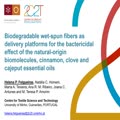
|

|
Show Abstract |
||||||||||||||||||||||||||||||||||||
|
Essential oils (EOs), which are complex biomolecules composed of volatile compounds, have emerged as a new strategy to deal with bacterial infections and as a valid alternative to synthetic drugs. Here, we report the modification of biodegradable wet-spun microfibers composed of cellulose acetate (CA) and polycaprolactone (PCL) with EOs, aiming at their localized, controlled release. Cinnamon leaf oil (CLO), cajeput oil (CJO), and clove oil (CO) were selected from a group of 20 EOs according to their minimal inhibitory concentration (MIC) against Staphylococcus aureus (<22.4 mg/mL) and Escherichia coli (<11.2 mg/mL). CA/PCL prepared at 10% and 14%wt in a 3/1 ratio in acetic acid and acetone were processed in the form of microfibers by wet-spinning at an extrusion rate of 0.5 mL/h directly into an ethanol coagulation bath. Microfibers were modified by immersion in ethanol solutions containing EOs at 2xMIC and ampicillin (control antibiotic). Incorporation was confirmed by UV-VIS, FTIR and TGA. After 72h, fibers contained ampicillin at MIC but only 14%, 66% and 76% of MIC for CLO, CO and CJO, respectively. Unloaded and loaded microfibers were characterized as uniform and homogeneous. Data showed that even at small amounts the EO-modified microfibers were effective against the tested bacteria. Considering the amount immobilized, CLO-containing fibers were deemed the most effective from the group, suggesting a superior affinity of the EOs active groups towards the CA/PCL matrix. These results indicate that CA/PCL microfibers loaded with EOs can be easily produced and applied in scaffolds for biomedical applications. |
|||||||||||||||||||||||||||||||||||||||||
| sciforum-038645 | Design and Synthesis of a cADPR Mimic as a Novel Tool for Monitoring the Intracellular Ca2+ concentration | , , , , , , , | N/A |

|
Show Abstract |
||||||||||||||||||||||||||||||||||||
|
Cyclic ADP-ribose (cADPR) is a natural occurring metabolite of NAD+ capable of mobilizing Ca2+ ions from intracellular stores. It was firstly isolated from sea urchin eggs extract, but it was later established that it is also produced in many other mammalian cells, including pancreatic β-cells, T-lymphocytes, smooth and cardiac muscle cells and cerebellar neurons, acting as a Ca2+-mobilizing agent. For this activity, cADPR has been classified as a second messenger that, activating the ryanodine receptors of the sarcoplasmatic reticulum, is able to mobilize the calcium ions from intracellular stores. cADPR is involved in many physiological processes related to the variation of the Ca2+ concentration, such as the synaptic homeostasis in neurons, as well as fertilization and cellular proliferation. This cyclic nucleotide, characterized by a very labile glycosidic bond at the N1, is rapidly hydrolysed also in neutral aqueous solutions to the inactive ADP-ribose. Matsuda and co-workers were the first who synthesized new analogues of the cADPR in which the adenine base was replaced by a hypoxanthine ring. This kind of modification produced the cyclic inosine diphosphate ribose (cIDPR) which proved to be stable in hydrolytic physiological conditions and showed significant Ca2+ mobilizing activity. A lot of modifications regarding the northern and southern ribose, as well as the purine base of cADPR, have been proposed so far. In our laboratories we have synthesized several analogues of cIDPR. In particular, the analogue with the northern ribose replaced by a pentyl chain (cpIDP) showed interesting Ca2+ mobilizing activity on the neuronal PC12 cell line. Starting from these results, we report here the synthesis of a novel analogue , in which the “northern” ribose of cIDPR was replaced by a 2”,3”-dihydroxy pentyl chain. |
|||||||||||||||||||||||||||||||||||||||||
| sciforum-037478 | De Novo Drug Design using Artificial Intelligence ASYNT-GAN | , | N/A |

|
Show Abstract |
||||||||||||||||||||||||||||||||||||
|
Since the last few decades, proteins have emerged as the major class of pharmaceuticals with more than 200 protein-based products currently available in the market, of which 90% are used as therapeutics. The protein engineering market is bolstered by the need for drugs with improved efficiency, specificity, technological capabilities, rise of antibody based drugs and steady growth in the therapeutic market. Monoclonal antibodies (mAbs) is the fastest growing segment in the therapeutic market, though the other segments comprising non-mAb recombinant proteins like Insulin, Erythropoetin (EPO), Interferons (INF),Interleukins (ILs) and Somatotropin (hGH) are also in great demand for therapy. In this paper we propose the generation of synthetic small and more sophisticated molecule structures that optimize the binding affinity to a target (ASYNT-GAN). To achieve this we leverage on three important achievements in A.I.: Attention, Deep Learning on Graphs and Generative Adversarial Networks. Similar to text generation based on parts of text we are able to generate a molecule architecture based on an existing target. By adopting this approach, we propose a novel way of searching for existing compounds that are suitable candidates. Similar to question and answer Natural Language solutions we are able to find drugs with highest relevance to a target. We are able to identify substructures of the molecular structure that are the most suitable for binding. In addition, we are proposing a novel way of generating the molecule in 3D space in such a way that the binding is optimized. We show that we are able to generate compound structures and protein structures that are optimised for binding to a target. |
|||||||||||||||||||||||||||||||||||||||||
Live Online Sessions
Two live online sessions with a series of keynote and selected speakers have been programmed. During each session, the participants will have the possibility to ask questions live to our speakers.
In order to attend the live sessions, please register in the section below. The live sessions are FREE. The number of participants to the live session is limited but the recording will be made available on Sciforum shortly afterwards. Registrations with academic institutional email addresses will be prioritized.
Program Live Online Sessions
|
Session: Natural and Bio-Inspired Therapeutics for Human Diseases I |
|
| Time (CET) | Speakers & Talks |
|
14:00 – 14:20 |
Dr. Marc Maresca, Prof. Dr. Vladimir Uversky and Prof. Dr. Prakash Kulkarni Welcome from the Conference Chairs |
|
14:20 – 14:40 Selected talk 1 |
Padmavathi Ramanujam, Meenakshi Sundararajan Engineering College, India. Discrimination of Acne Vulgaris With Human Scalp Hair Tissues Using FTIR-ATR Spectroscopy |
|
14:40 – 15:00 Selected talk 2 |
Mohammad Abu Raihan Uddin, University of Science and Technology Chittagong (USTC), Bangladesh. Can Phytochemicals Inhibit TNF-alpha? |
|
15:00 – 15:20 Selected talk 3 |
Abdulrasheed O. Abdulrahman, King Abdulaziz University, Saudi Arabia. Urolithin Is a Potential Modulator of Key Gut Microbes Related to Obesity. |
|
15:20 – 15:40 Selected talk 4 |
Catarina S. Miranda, University of Minho, Portugal Bactericidal Effect of Clo Loaded Onto Chitosan Microcapsules-Modified Biodegradable Hydrogel-Like Films: An Alternative for Treating Pseudomonas Aeruginosa Infections |
|
15:40 – 15:50 |
Wrap up and concluding remarks, Session Chairs |
|
Session: Natural and Bio-Inspired Therapeutics for Human Diseases II |
|
| Time (CET) | Speakers & Talks |
|
17:00-17:40 Keynote talk |
Prof. Dr. James J. Collins, Massachusetts Institute of Technology, the Broad Institute, and Harvard's Wyss Institute, USA Harnessing Synthetic Biology and Deep Learning to Fight Pandemics |
|
17:40-18:00 Selected talk 1 |
Ivan Jacobs, AI4U, Luxembourg De Novo Drug Design using Artificial Intelligence ASYNT-GAN |
|
18:00-18:20 Selected talk 2 |
Dr. María Cristina Vanrell, Universidad Nacional de Cuyo, Argentina Ursolic Acid Promotes Clearance of Trypanosoma Cruzi Amastigotes in the Host Cell |
|
18:20-18:40 Selected talk 3 |
Dr. Joanna Bojarska, Lodz University of Technology, Poland Ultra Short Cyclo-Peptides as Bio-Inspired Therapeutics: Proline-Based 2,5-Diketopiperazines (DKP) |
|
18:40 – 18:50 |
Wrap up and concluding remarks, Session Chairs |
Live Online Sessions Content
In this section, you will find the recordings of the live sessions to watch, re-watch and share with your colleagues.
7 December 2020
10 December 2020
Instructions for Authors
To present your research at the IECBM2020:
- Create an account on Sciforum if you do not already have one, then click on ‘New Submission’ on the upper-right corner of the window, or click on ‘Submit Abstract’ at the top of this webpage.
- Submit an abstract in English (150–300 words) before 21 October 2020.
- The Conference Committee will evaluate all submitted abstracts, and authors will be notified by 30 October 2020 regarding acceptance.
- The authors of accepted contributions will be invited to submit a conference paper before 9 November 2020. In addition, authors will be encouraged to submit a slide, poster, and/or a video presentation of their work to accompany their manuscript (optional).
- All accepted manuscripts and presentations will be available online for discussion and for rating during the conference period (1–13 December 2020). After the conference, they will remain available online for reading at Sciforum.net.
- All accepted conference papers will be published in the proceedings of this e-conference within a dedicated issue of the MDPI journal Proceedings.
- Participants of this e-conference will be also encouraged to submit a full paper to a dedicated Special Issue in Biomolecules with a 20% discount on the article processing charge (APC).
Conference papers must be prepared using the Proceedings template (word template here and latex template here), and following this organization:
- Title
- Full author names
- Affiliations (including full postal address) and authors’ e-mail addresses
- Abstract
- Keywords
- Introduction
- Methods
- Results and Discussion
- Conclusions
- (Acknowledgements)
- References
Manuscripts should be prepared in MS Word or any other word processor and converted to PDF format before submission. The publication format will be PDF. The manuscript should be at least four pages (including figures, tables, and references). There is no page limit on the length, although authors are requested to keep their papers as concise as possible.
Please carefully read the rules outlined in the Instructions for Authors on the journal website and ensure that your manuscript submission adheres to these guidelines.
Microsoft Word
Authors must use the Microsoft Word template to prepare their manuscript. Using the template file will substantially shorten the time to complete copy-editing and publication of accepted manuscripts. Manuscript prepared in MS Word must be converted into a single file before submission. Please do not insert any graphics (schemes, figures, etc.) into a movable frame which can superimpose on the text and make the layout very difficult.
LaTeX
Manuscripts prepared in LaTeX must be collated into one ZIP folder (include all source files and images, so that the Conference Secretariat can recompile the submitted PDF). When preparing manuscripts in LaTeX, please use the LaTeX template file.
Presentation slides
Authors are encouraged to prepare a presentation in PowerPoint (or similar) to be displayed online along with the manuscript. Slides can be prepared the same way as for any traditional conference. They should be converted to PDF format before submission.
Video Presentations
Authors are also encouraged to submit video presentations. Videos will be available at Sciforum. The video should be no longer than 10 minutes and be prepared in one of the following formats:
- .MOV
- .MPEG4
- .MP4
- .AVI
- .WMV
- .MPEG-PS
- .FLV
Posters
Posters will be available on this conference website during and after the event. Like papers presented on the conference, participants will be able to ask questions and make comments about the posters. Posters can be presented without an accompanying proceedings paper and will be available online on this website during and after the e-conference. However, they will not be added to the proceedings of the conference. For detailed instructions on how to submit a poster, please contact us at iecbm2020@mdpi.com.
All authors must disclose all relationships or interests that could inappropriately influence or bias their work. This should be conveyed in a separate “Conflict of Interest” statement preceding the “Acknowledgments” and “References” sections at the end of the manuscript. If there are no conflicts, please state “The authors declare no conflicts of interest”. Financial support for the study must be fully disclosed under the “Acknowledgments” section.
MDPI, the owner of the Sciforum.net platform, is an open access publisher. We believe that authors should retain the copyright to their scholarly works. Hence, by submitting a Communications paper to this conference, you retain the copyright of your paper but grant MDPI the nonexclusive right to publish this paper online via the Sciforum.net platform. This means you can easily submit your paper to any scientific journal at a later stage and transfer the copyright to that publisher (if required by the publisher).
Event Awards
The Awards
Number of Awards Available: 1
300 CHF + publication waiver in Biomolecules JournalNumber of Awards Available: 1
300 CHFTerms and Conditions:
Only full conference papers will be eligible for the Best Paper Award.
Evaluation Criteria:
- Originality / Novelty
- Significance of content
- Scientific soundness
- Interest to the readers
- English language and style
Evaluation Process:
- Each Evaluation Committee member will assess the criteria outlined above for each application.
- Presentations will be ranked from highest to lowest total score.
- If two or more authors get the same score, further evaluation will be carried out.
- Winners will be announced online after the conference.
Awards Winners Announcement
We are pleased to announce the winners of Best Paper Award and Best Poster Award of IECBM2020:
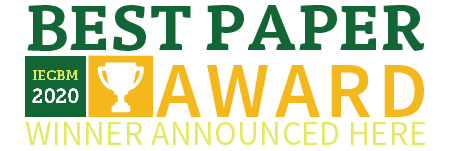 |
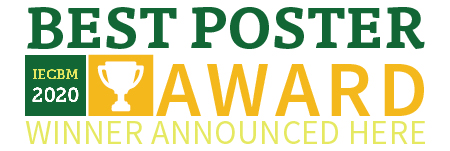 |
|
Winner: Ursolic acid promotes clearance of Trypanosoma cruzi amastigotes in the host cell (doi:10.3390/IECBM2020-08807) María Cristina Vanrell, Santiago Martinez, Lucila Muñoz, Betiana Nebaí Salassa and Patricia Romano* |
Winner: Antibacterial Activity of Specialized Biomolecules (doi:10.3390/IECBM2020-08819) Tânia D. Tavares*, Joana C. Antunes, Jorge Padrão, Ana I. Ribeiro, Andrea Zille, M. Teresa P. Amorim, Fernando Ferreira and Helena P. Felgueiras |
Special Issue
Selected Papers from the 1st International Electronic Conference on Biomolecules
Guest Editors: Dr. Marc Maresca, Prof. Dr. Vladimir Uversky, Prof. Dr. Prakash Kulkarni
Deadline for manuscript submissions: 30 June 2021
S1. The natural and bio-inspired drug universe
Session Chair
Dr. Marc Maresca, Aix-Marseille University, CNRS, Centrale Marseille, iSm2, F-13013 Marseille, France
Show all published submissions (11) Hide published submissions (11)
Submissions
List of Papers (11) Toggle list
S3. Pathways for the discovery of new bio-inspired and natural drugs and their derivatives
Show all published submissions (8) Hide published submissions (8)
Submissions
List of Papers (8) Toggle list
S4. Repurposing of previously approved natural and bio-inspired drugs
Session Chair
Prof. Dr. Marta Martins, Trinity College Dublin, Dublin, Ireland
Show all published submissions (1) Hide published submissions (1)
Submissions
List of Papers (1) Toggle list
PS. Poster Session
Show all published submissions (5) Hide published submissions (5)
Submissions
List of Papers (5) Toggle list




























